Art C Two Oxygen Atoms Combine With a Carbon Atom to Form a Carbon Dioxide Molecule
Molecules of Life P1, P2, M1
P1: Describe the structure of hydrogen, carbon, oxygen and nitrogen and chronicle these to the construction of biological molecules
M1: Explain the relevance of the electronic configuration of hydrogen, carbon, oxygen and nitrogen
Hydrogen
Hydrogen is used in petrol and diesel cars, the called-for of fuel produce carbon dioxide and h2o. An element has ane blazon of cantlet and information technology cannot exist broken down into other substances. Well-nigh carbon compounds incorporate hydrogen and hydrogen forms compounds with all other elements. Compounds of hydrogen are ordinarily called hydrides, even though the hydride describes compounds that take an H- ion.
(Carr and Carr, 2018) Hydrogen is the simplest course of atom; it has a nucleus like whatever other atom and the nucleus of the hydrogen is fabricated of one proton and around the nucleus, there is one electron which goes round the nucleus. The proton particle has a positive electrical charge which is the opposite of the electron.
Because hydrogen has one electron, two hydrogen atoms will therefore share ane electron between the two to class a covalent bond and this will make a hydrogen molecule.
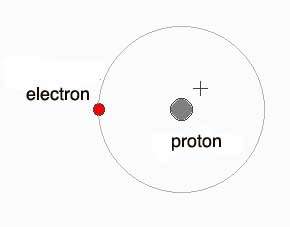
Pic: https://quatr.us/chemistry/hydrogen-atoms-chemistry.htm
Carbon
(Carr and Carr, 2018) Carbon is heavier than hydrogen atoms because they have 6 protons and 6 neutrons on the nucleus and 6 electrons going circular the exterior. For carbon at that place are two shells going around the nucleus because not all 6 electrons can keep around the nucleus at the same time, so 2 electrons can only fit in the inner beat and the residual on the other shell. With the outer beat out, it tin hold upwardly to 8 electrons which make information technology easier for it to combine with other atoms to make even bigger molecules.
Carbon is known to be special compared to other atoms because it can bond with other carbon atoms to an unlimited extent; this is considering it is small in size and tin fit every bit part of larger molecules.
Hydrogen bonds tin be replaced with another carbon atom covalently bonded to the first carbon cantlet. With this happening the long chains of carbon compounds can be made. Nitrogen, oxygen, and phosphorus tin as well bail with the carbon atoms, and these molecules form rings which and so tin can link with other rings.
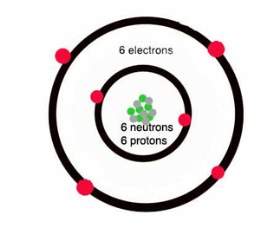
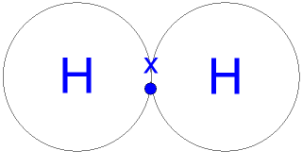
Picture: https://quatr.united states of america/chemical science/carbon-atoms-chemical science.htm
Picture: http://www.gcsescience.com/a24-covalent-bond-hydrogen-gas-molecule.htm
Oxygen
Oxygen is an chemical element that is formed by compounds by reaction with whatever other elements. All of the atoms are oxygen atoms but they do not exist separately so what would happen is that they would part upwardly to form oxygen molecules.
(Gcsescience.com, 2018) Oxygen is heavier than hydrogen and carbon because of the number of protons, neutrons and electrons. An oxygen atom has 8 protons, 8 neutrons and 8 electrons around the nucleus. In that location are 2 electrons in the inner shell because that's how much an inner trounce can behave and 6 electrons on the outer crush. 2 oxygen bonds will each share two electrons to form covalent bonds and make an oxygen molecule.
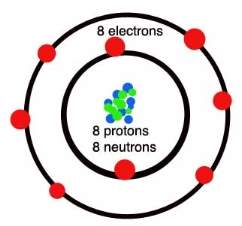
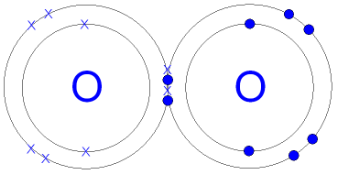
Pic one: https://quatr.us/chemistry/oxygen-atoms-elements-chemistry.htm
Picture 2: http://www.gcsescience.com/a26-covalent-bond-oxygen-gas-molecule.htm
Nitrogen
(Gcsescience.com, 2018) Nitrogen'due south structure has seven protons, 7 neutrons and 7 electrons. 2 electrons on the inner shell and 5 electrons on the outer ring. What happens is that because there are 5 electrons on the outer beat, two nitrogen atoms will share iii of the electrons to form three covalent bonds. This and so makes a nitrogen molecule. By sharing six electrons on both sides of where the shells are touching, each of the nitrogen atoms tin count 8 electrons in the outer ring. Eight electrons on each atom testify that the shared electrons are stable considering the outer ring will be full.

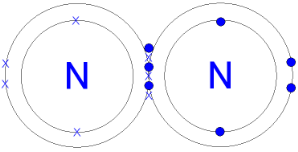
Moving-picture show: https://quatr.united states of america/chemistry/nitrogen-atoms-elements-chemistry.htm
Picture: http://www.gcsescience.com/a25-covalent-bond-nitrogen-gas-molecule.htm
Biological Molecules
Carbohydrates, proteins, and lipids are biological molecules because they are congenital from smaller organic molecules. Each ane of these has its ain function because they are all an important component of the cell. Biological molecules are organic, this ways that they contain carbon.
Carbohydrates
(Khan Academy, 2018) Carbohydrates are compounds that provide energy through a procedure called oxidation, they supple carbon for the synthesis of cell components, they serve as a form of chemical free energy and they are role of the structures of some cells and tissues.
Carbohydrates are made upwards of carbon, hydrogen and oxygen, and the carbohydrates chains come in different length sizes and in three different categories: monosaccharides, disaccharides and polysaccharides.

Picture: https://www.visionlearning.com/en/library/Biology/2/Carbohydrates/61
Proteins
(Reference, 2018) A protein is a biological molecule that is composed of polymers of amino acids joined together past peptide bonds. Proteins are different to carbohydrates and fats because it contains nitrogen. Proteins have many roles when involving the body; they do nearly of the piece of work in the cells and are required for the structure and regulation of the body'due south tissue and organs. They are about twenty different types of amino acids that are combined to brand a poly peptide.
Find Out How UKEssays.com Tin Aid You!
Our academic experts are ready and waiting to assist with any writing project you may have. From simple essay plans, through to total dissertations, yous tin guarantee we have a service perfectly matched to your needs.
View our services
(Mytutor.co.u.k., 2018) Proteins function is to transport and store other molecules such every bit oxygen. There are 4 stages of making a protein. The starting time stage is chosen the principal structure is the order of amino acids in the peptide. Secondary structure is the folding of the polypeptide concatenation. The tertiary structure is the 3D folding, and finally fourth structure is the protein being made.
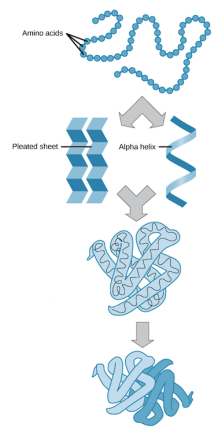
https://world wide web.khanacademy.org/science/biology/macromolecules/proteins-and-amino-acids/a/orders-of-poly peptide-structure
Lipids
(expii, 2018) Lipids are the other biological molecules that are fabricated from long carbon chains that is bonded by hydrogen. Lipids are insoluble meaning that they cannot be dissolved in water withal; they are soluble to non-polar molecules significant that will dissolve. Lipids include fats, fat soluble vitamins, phospholipids and triglycerides. The functions of lipids is to serve structural components of biological membranes, they provide energy. Body fat is a good source of free energy and it is stored equally adipose tissues. They can be used to create hormones and steroids that the torso uses to communicate from one cell to some other cell and organ or organ.
(Torresbioclan.pbworks.com, 2018) The cell membrane is composed of proteins and lipids. The lipids help the membrane exist flexible, the proteins help monitor and maintain and cells chemical climate, and it likewise transfers molecules across the membrane. Phospholipids have a head which is chosen a hydrophilic head and it has a tail called a hydrophobic tail. This ways that the caput is polar and the tail in non-polar. Phospholipids have a polar phosphate group which is hydrophilic which means it volition face the aqueous solution because it is water loving. The fatty acid tails will motility abroad from the aqueous solution because information technology id h2o—hating.
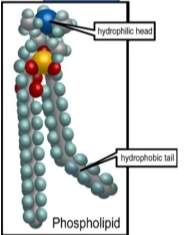
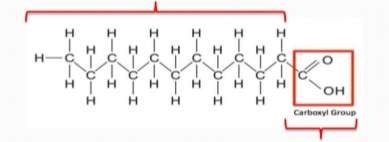
Picture: https://slideplayer.com/slide/8378455/
Picture: https://www.slideshare.net/sidrajaved2/lipids-62895056
P2: Describe the structure of water and carbon dioxide with reference to dissimilar types of bonding
Water
(Worldofmolecules.com, 2018) H2o is a polar molecule and a chemical compound. A water molecule consists of ii hydrogen atoms and an oxygen atom, its' molecular formula is H2O. A h2o molecule is formed at an angle where the hydrogen atoms at the end and oxygen in the middle. Since oxygen has a college electronegativity than hydrogen in general, the oxygen atoms accept something called a partial negative charge. When this accuse is and so unlike, it is then chosen a dipole, and because of the charge difference, h2o molecules are attracted to each other. The relatively positive charged ones are attracted to the relatively negative ones. This allure is called hydrogen bonding. The oxygen of ane h2o molecule has ii lonely pairs of electrons; each of them can form hydrogen bonds with hydrogens on two other h2o molecules. This can carry on happening so that every water molecule is H bonded with four other molecules.
(Gcsescience.com, 2018) A covalent bond is formed when there is a sharing of an electron between two atoms. Water molecules take a covalent bail because in that location is a share of electrons that take place betwixt the Hydrogen atom and the Oxygen atom and their electronic configuration. Hydrogen has one only electron in its outer vanquish and oxygen has viii electrons in its outer shell. What will happen is that the 2 hydrogen bonds volition share their one electron with oxygen to form 2 covalent bonds and then this can make a water molecule. By sharing the two electrons where the hydrogen cantlet can count 2 electrons and oxygen can count eight. With hydrogen and oxygen sharing, it is now stable and the h2o molecule will not react with any other oxygen and hydrogen atoms.
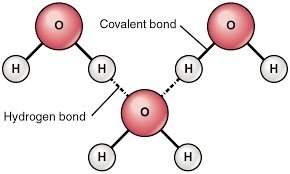
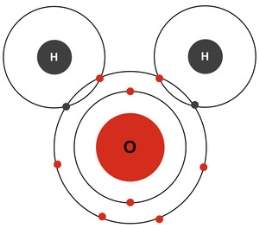
Picture: https://healingearth.ijep.net/water/structure-water
Picture: https://www.quora.com/If-hydrogen-bonds-didnt-exist-what-would-it-await-similar-when-h2o-dripped-off-of-y'all
Carbon Dioxide
(Gcsescience.com, 2018) Carbon dioxide is a simple covalent molecule, its' molecular formula is a carbon cantlet joined by ii pairs of double bonds to the oxygen atoms O=C=O (CO2), carbon and oxygen are both non-metals. An oxygen cantlet has six electrons in its outer shell and a carbon cantlet has 4 electrons on its outer shell. The two oxygen atoms and 2 carbon atoms volition share 2 electrons to course iv covalent bonds, past doing this it volition brand a carbon dioxide molecule. With those iv electrons being shared, each oxygen and carbon atom tin can and so count 8 electrons in its outer beat out. Now the electrons on each atom are full of eight electrons, it is now stable and the carbon dioxide molecule volition non react with whatsoever other oxygen or carbon atom.
The reason it is a double bond is because the carbon and oxygen has two bonds between the atoms. In that location are no ions present, meaning that there are no positive or negative charges in carbon dioxide gas. This is considering the electrons are shared and not transferred from ane cantlet to another.
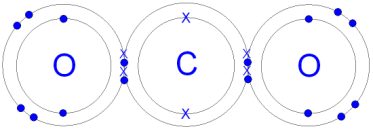
 #
#
Bibliography
CARBOHYDRATES
Khan University. (2018). Carbohydrates. [online] Available at: https://world wide web.khanacademy.org/scientific discipline/biological science/macromolecules/carbohydrates-and-sugars/a/carbohydrates [Accessed 11 Dec. 2018].
CARR, K. AND CARR, K.
What is hydrogen? Atoms and Chemical science | Quatr.us Study Guides
Carr, K. and Carr, Chiliad. (2018). What is hydrogen? Atoms and Chemistry | Quatr.us Written report Guides. [online] Quatr.us Study Guides. Available at: https://quatr.united states/chemistry/hydrogen-atoms-chemical science.htm [Accessed 10 December. 2018].
CARR, M. AND CARR, K.
What is carbon? Atoms – Chemistry | Quatr.the states Written report Guides
Carr, 1000. and Carr, K. (2018). What is carbon? Atoms – Chemistry | Quatr.usa Study Guides. [online] Quatr.united states of america Study Guides. Available at: https://quatr.us/chemical science/carbon-atoms-chemistry.htm [Accessed 10 December. 2018].
Chemic STRUCTURE OF LIPIDS – EXPII
expii. (2018). Chemical Structure of Lipids – Expii. [online] Bachelor at: https://world wide web.expii.com/t/chemical-structure-of-lipids-5531 [Accessed 12 Dec. 2018].
DESCRIBE THE STRUCTURE OF PROTEINS | MYTUTOR
Mytutor.co.uk. (2018). Draw the structure of proteins | MyTutor. [online] Available at: https://www.mytutor.co.uk/answers/3662/A-Level/Biology/Describe-the-structure-of-proteins/ [Accessed 11 Dec. 2018].
GCSE Chemical science – COVALENT BONDING IN A CARBON DIOXIDE MOLECULE – WHAT IS THE STRUCTURE OF A CARBON DIOXIDE MOLECULE? – GCSE Science.
Gcsescience.com. (2018). GCSE CHEMISTRY – Covalent Bonding in a Carbon Dioxide Molecule – What is the Structure of a Carbon Dioxide Molecule? – GCSE Science.. [online] Bachelor at: http://www.gcsescience.com/a27-covalent-bond-carbon-dioxide-gas-molecule.htm [Accessed 12 Dec. 2018].
GCSE CHEMISTRY – COVALENT BONDING IN A NITROGEN MOLECULE – WHAT IS THE Structure OF A NITROGEN MOLECULE? – GCSE SCIENCE.
Gcsescience.com. (2018). GCSE CHEMISTRY – Covalent Bonding in a Nitrogen Molecule – What is the Structure of a Nitrogen Molecule? – GCSE Scientific discipline.. [online] Available at: http://www.gcsescience.com/a25-covalent-bail-nitrogen-gas-molecule.htm [Accessed 10 December. 2018].
GCSE CHEMISTRY – COVALENT BONDING IN A WATER MOLECULE – WHAT IS THE Structure OF A Water MOLECULE? – GCSE Scientific discipline.
Gcsescience.com. (2018). GCSE CHEMISTRY – Covalent Bonding in a Water Molecule – What is the Structure of a H2o Molecule? – GCSE Scientific discipline.. [online] Available at: http://www.gcsescience.com/a30-covalent-bond-water-molecule.htm [Accessed 12 Dec. 2018].
GCSE Chemistry – COVALENT BONDING IN AN OXYGEN MOLECULE – WHAT IS THE Construction OF AN OXYGEN MOLECULE? – GCSE SCIENCE.
Gcsescience.com. (2018). GCSE Chemistry – Covalent Bonding in an Oxygen Molecule – What is the Structure of an Oxygen Molecule? – GCSE SCIENCE.. [online] Available at: http://world wide web.gcsescience.com/a26-covalent-bail-oxygen-gas-molecule.htm [Accessed 10 December. 2018].
REFERENCE, G.
What are proteins and what do they do?
Reference, M. (2018). What are proteins and what do they practise?. [online] Genetics Dwelling house Reference. Available at: https://ghr.nlm.nih.gov/primer/howgeneswork/protein [Accessed 11 December. 2018].
THE WATER MOLECULE
Worldofmolecules.com. (2018). The Water Molecule. [online] Available at: https://www.worldofmolecules.com/solvents/water.htm [Accessed 12 Dec. 2018].
TORRESBIOCLAN / CELL MEMBRANE – Squad SMART
Torresbioclan.pbworks.com. (2018). torresbioclan / prison cell membrane – team sMART. [online] Available at: http://torresbioclan.pbworks.com/w/folio/22377072/cell%20membrane%twenty-%20team%20sMART [Accessed 12 Dec. 2018].
Source: https://www.ukessays.com/essays/chemistry/structure-of-hydrogen-carbon-oxygen-and-nitrogen.php
0 Response to "Art C Two Oxygen Atoms Combine With a Carbon Atom to Form a Carbon Dioxide Molecule"
Post a Comment